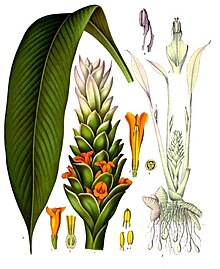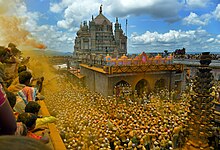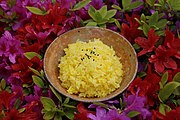Turmeric
| Turmeric | |
|---|---|

| |
| Inflorescence of Curcuma longa | |

| |
| Turmeric rhizome and powder | |
| Scientific classification | |
| Kingdom: | Plantae |
| Clade: | Tracheophytes |
| Clade: | Angiosperms |
| Clade: | Monocots |
| Clade: | Commelinids |
| Order: | Zingiberales |
| Family: | Zingiberaceae |
| Genus: | Curcuma |
| Species: | C. longa
|
| Binomial name | |
| Curcuma longa | |
| Synonyms | |
|
Curcuma domestica Valeton | |
Turmeric (
The rhizomes are used fresh or boiled in water and dried, after which they are ground into a deep orange-yellow powder commonly used as a coloring and flavoring agent in many Asian cuisines, especially for curries, as well as for the dyeing characteristics imparted by the principal turmeric constituent, curcumin.[6]
Turmeric powder has a warm, bitter,
Curcumin, a bright yellow chemical produced by the turmeric plant, is approved as a food additive by the World Health Organization, European Parliament, and United States Food and Drug Administration.[6]
Although long used in Ayurvedic medicine, there is no high-quality clinical evidence that consuming turmeric or curcumin is effective for treating any disease.[9][10]

Origin and distribution
The greatest diversity of Curcuma species by number alone is in India, at around 40 to 45 species. Thailand has a comparable 30 to 40 species. Other countries in tropical Asia also have numerous wild species of Curcuma. Recent studies have also shown that the taxonomy of C. longa is problematic, with only the specimens from South India being identifiable as C. longa. The phylogeny, relationships, intraspecific and interspecific variation, and even identity of other species and cultivars in other parts of the world still need to be established and validated. Various species currently utilized and sold as "turmeric" in other parts of Asia have been shown to belong to several physically similar taxa, with overlapping local names.[11][12]
History
Turmeric has been used in Asia for centuries and is a major part of
From India, it spread to Southeast Asia along with Hinduism and Buddhism, as the yellow dye is used to color the robes of monks and priests. Turmeric has also been found in Tahiti, Hawaii and Easter Island before European contact.[16] There is linguistic and circumstantial evidence of the spread and use of turmeric by the Austronesian peoples into Oceania and Madagascar. The populations in Polynesia and Micronesia, in particular, never came into contact with India, but use turmeric widely for both food and dye. Thus independent domestication events are also likely.[14][15]
Turmeric was found in
Etymology
The name possibly derives from Middle English or Early Modern English as turmeryte or tarmaret. It may be of Latin origin, terra merita ("meritorious earth").[18] The Latin specific epithet longa means long.[19]
Description
This section needs additional citations for verification. (June 2021) |
Turmeric is a
The leaves are alternate and arranged in two rows. They are divided into leaf sheath, petiole, and leaf blade.[1] From the leaf sheaths, a false stem is formed. The petiole is 50 to 115 cm (20–45 in) long. The simple leaf blades are usually 76 to 115 cm (30–45 in) long and rarely up to 230 cm (7 ft 7 in). They have a width of 38 to 45 cm (15 to 17+1⁄2 in) and are oblong to elliptical, narrowing at the tip.[1]
Inflorescence, flower, and fruit
At the top of the inflorescence, stem bracts are present on which no flowers occur; these are white to green and sometimes tinged reddish-purple, and the upper ends are tapered.[20]
The
In East Asia, the flowering time is usually in August. Terminally on the false stem is an inflorescence stem, 12 to 20 cm (4+1⁄2 to 8 in) long, containing many flowers. The bracts are light green and ovate to oblong with a blunt upper end with a length of 3 to 5 cm (1 to 2 in).[20]
-
Curcuma domestica Valeton, a drawing by A. Bernecker around 1860
-
Turmeric farm on Deccan Plateau
-
Turmeric flower
Phytochemistry


Turmeric powder is about 60–70%
Uses
Culinary
This section needs additional citations for verification. (June 2017) |
Turmeric is one of the key ingredients in many Asian dishes, imparting a mustard-like, earthy aroma and pungent, slightly bitter flavor to foods.[7][8] It is used mostly in savory dishes, but also is used in some sweet dishes, such as the cake sfouf. In India, turmeric leaf is used to prepare special sweet dishes, patoleo, by layering rice flour and coconut-jaggery mixture on the leaf, then closing and steaming it in a special utensil (chondrõ).[27] Most turmeric is used in the form of rhizome powder to impart a golden yellow color.[7][8] It is used in many products such as canned beverages, baked products, dairy products, ice cream, yogurt, yellow cakes, orange juice, biscuits, popcorn, cereals and sauces. It is a principal ingredient in curry powders.[7][28] Although typically used in its dried, powdered form, turmeric also is used fresh, like ginger.[28]
Turmeric is used widely as a spice in South Asian and Middle Eastern cooking. Various Iranian khoresh recipes begin with onions caramelized in oil and turmeric. The Moroccan spice mix ras el hanout typically includes turmeric. In South Africa, turmeric is used to give boiled white rice a golden color, known as geelrys (yellow rice) traditionally served with bobotie. In Vietnamese cuisine, turmeric powder is used to color and enhance the flavors of certain dishes, such as bánh xèo, bánh khọt, and mì Quảng. The staple Cambodian curry paste, kroeung, used in many dishes, including fish amok, typically contains fresh turmeric. In Indonesia, turmeric leaves are used for Minang or Padang curry base of Sumatra, such as rendang, sate padang, and many other varieties. In the Philippines, turmeric is used in the preparation and cooking of kuning, satti, and some variants of adobo. In Thailand, fresh turmeric rhizomes are used widely in many dishes, in particular in the southern Thai cuisine, such as yellow curry and turmeric soup. Turmeric is used in a hot drink called "turmeric latte" or "golden milk" that is made with milk, frequently coconut milk.[29] The turmeric milk drink known as haldī dūdh (haldī [हलदी] means turmeric in Hindi) is a traditional Indian recipe. Sold in the US and UK, the drink known as "golden milk" uses nondairy milk and sweetener, and sometimes black pepper after the traditional recipe (which may also use ghee).[29]
Turmeric is approved for use as a
In combination with annatto (E160b), turmeric has been used to color numerous food products.[6][28] Turmeric is used to give a yellow color to some prepared mustards, canned chicken broths, and other foods—often as a much cheaper replacement for saffron.[28][30]
-
Cleaning turmeric rhizomes with boiling water
-
Drying turmeric rhizomes
-
Turmeric powder
-
Cooked vegetables with turmeric as one of its key ingredients, referred to as Sabzi, a dish from India
-
Ganghwang-bap(turmeric rice)
-
Goan Catholicstyle
Traditional uses

In 2019, the European Medicines Agency concluded that turmeric herbal teas, or other forms taken by mouth, on the basis of their long-standing traditional use, could be used to relieve mild digestive problems, such as feelings of fullness and flatulence.[31]
Turmeric grows wild in the forests of South and Southeast Asia, where it is collected for use in classical Indian medicine (Siddha or Ayurveda).
In
Turmeric makes a poor fabric dye, as it is not light fast, but is commonly used in Indian clothing, such as saris and Buddhist monks' robes.[8] During the late Edo period (1603–1867), turmeric was used to dilute or substitute more expensive safflower dyestuff in the production of beni itajime shibori.[35]: 1 Friedrich Ratzel reported in The History of Mankind during 1896, that in Micronesia, turmeric powder was applied for embellishment of body, clothing, utensils, and ceremonial uses.[36] Native Hawaiians who introduced it to Hawaii (Hawaiian: ʻōlena) make a bright yellow dye out of it.[37]
Indicator

Turmeric paper, also called curcuma paper or in German literature, Curcumapapier, is paper steeped in a
Adulteration
As turmeric and other spices are commonly sold by weight, the potential exists for powders of toxic, cheaper agents with a similar color to be added, such as lead(II,IV) oxide ("red lead"). These additives give turmeric an orange-red color instead of its native gold-yellow, and such conditions led the US Food and Drug Administration (FDA) to issue import alerts from 2013 to 2019 on turmeric originating in India and Bangladesh.[40] Imported into the United States in 2014 were approximately 5.4 million kilograms (12 million pounds) of turmeric, some of which was used for food coloring, traditional medicine, or dietary supplement.[40] Lead detection in turmeric products led to recalls across the United States, Canada, Japan, Korea, and the United Kingdom through 2016.[40]
Another common adulterant in turmeric,
Medical research
Turmeric and curcumin have been studied in numerous clinical trials for various human diseases and conditions, with no high-quality evidence of any anti-disease effect or health benefit.[9][10][43][44] There is no scientific evidence that curcumin reduces inflammation, as of 2020[update].[9][10][45] There is weak evidence that turmeric extracts may be beneficial for relieving symptoms of knee osteoarthritis,[46] as well as for reducing pain and muscle damage following physical exercise.[47] There is good evidence that turmeric is an allergen.[48]
See also
References
- ^ a b c d e "Curcuma longa L." Plants of the World Online. Royal Botanic Gardens, Kew. Retrieved 26 March 2018.
- ^ "turmeric". Dictionary.com Unabridged (Online). n.d.
- ^ "turmeric". Merriam-Webster.com Dictionary.
- ^ "curcuma". Dictionary.com Unabridged (Online). n.d.
- ^ "longa". Merriam-Webster.com Dictionary.
- ^ a b c d e f g Curcumin from PubChem
- ^ a b c d "Turmeric". Drugs.com. 2009. Retrieved 24 August 2017.
- ^ a b c d Brennan, J (15 October 2008). "Turmeric". The National.
- ^ PMID 28074653.
None of these studies [has] yet led to the approval of curcumin, curcuminoids, or turmeric as a therapeutic for any disease
- ^ a b c d "Turmeric". National Center for Complementary and Integrative Health, US National Institutes of Health. May 2020. Retrieved 25 November 2020.
- .
- ISBN 9780123948243.
- ISSN 0011-3891. Retrieved 16 March 2013.
- ^ ISBN 9789027292940. Archived from the original(PDF) on 25 November 2021. Retrieved 18 January 2019.
- ^ S2CID 20513984.
- ^ ISBN 0415927463.
- PMID 33419922.
- ^ "turmeric". Dictionary.com Unabridged (Online). n.d. Retrieved 11 October 2012.
- ^ "Curcuma longa - Plant Finder". www.missouribotanicalgarden.org. Retrieved 11 July 2023.
- ^ a b "Curcuma longa". Flora of China. Retrieved 30 November 2013 – via eFloras.org, Missouri Botanical Garden, St. Louis, MO & Harvard University Herbaria, Cambridge, MA.
- ISBN 978-3-0348-5239-5.
- ISBN 978-3-642-58087-1.
- S2CID 12581076.
- PMID 25177723.
- PMID 24311554.
- PMID 14558784.
- ^ Pereira Kamat, M (16 August 2008), "A tradition wrapped in leaves", The Times of India, Goa, India, archived from the original on 9 October 2018, retrieved 16 August 2017
- ^ a b c d e "E100: Curcumin". UKfoodguide.net. Archived from the original on 7 July 2017. Retrieved 14 April 2017.
- ^ a b Imtiaz, Sabia (11 May 2016). "Turmeric latte: the 'golden milk' with a cult following". The Guardian. Retrieved 7 January 2018.
- ISBN 9788178330389.
- ^ "Curcuma longa L., rhizoma". European Medicines Agency. 14 February 2019. Retrieved 19 November 2020.
- ^ Khan, Maheen (11 November 2014). "A Bangladeshi Wedding Journal – Gaye Holud: Pre-Wedding Ceremony". The Daily Star. Retrieved 22 February 2017.
- ISBN 9788179911006.
- ^ Ramadurai, Charukesi. "India's original "turmeric latte"". www.bbc.com. Retrieved 24 August 2023.
- ^ Arai, Masanao; Iwamoto Wada, Yoshiko (2010). "BENI ITAJIME: CARVED BOARD CLAMP RESIST DYEING IN RED" (PDF). Textile Society of America Symposium Proceedings. Lincoln: University of Nebraska. Archived from the original on 2 November 2021.
- ^ Ratzel, Friedrich (1896). The History of Mankind. London: MacMillan.
- ^ Welch, Zoe (27 May 2020). "Making dye from native and canoe plants". Mānoa Heritage Centre. Retrieved 28 October 2022.
- ISBN 9781420006322.
- ISBN 978-3-527-32516-0.
- ^ PMID 28358991.
- ^ PMID 31550596.
- ^ "Producing and distributing food – guidance: Chemicals in food: safety controls; Sudan dyes and industrial dyes not permitted in food". Government of the United Kingdom. 8 October 2012. Retrieved 12 December 2015.
- PMID 27533649.
- S2CID 46429012.
- S2CID 163166501.
- S2CID 231724282. Archived from the original(PDF) on 26 May 2023.
- S2CID 215759520.
- PMID 26705440.
External links
 The dictionary definition of turmeric at Wiktionary
The dictionary definition of turmeric at Wiktionary









